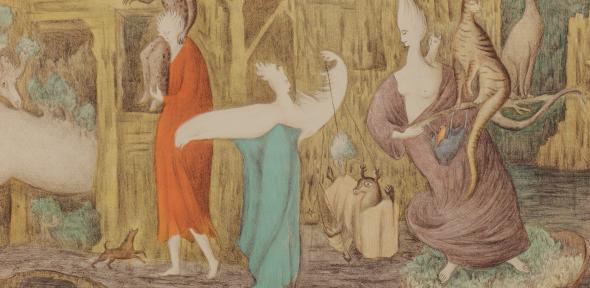Institute of Continuing Education (ICE)

Submitted by Amy Kingham on Thu, 06/01/2022 - 11:24
ICE already offers popular History of Art courses at undergraduate level, but in 2022, the Institute presents its first part-time Master of Studies in History of Art and Visual Culture.
ICE’s new MSt is no ordinary survey, though. Instead, it takes a fresh look at a classic subject by organising learning around pressing, contemporary themes. Academic Director, Dr Lydia Hamlett, tells us more.
Traditionally, History of Art courses are arranged by subject area, often with a strict chronology. We’ve shaken that up by structuring the teaching thematically. The theme dictates the content of each term,” says Lydia, as she reveals the exciting twist to ICE’s new Master’s. “It means we cover a broad range of art and approaches, from early examples to the modern era, within the same teaching block.
In the first term, Thinking across Media encourages students to consider the many visual influences on an artist and how different media may have interacted when they produced their work.
“Intermediality is a key topic for art historians right now,” observes Lydia. “It’s a lens through which we can challenge traditional hierarchies. For example, while in the past, we might have focused solely on a painting as ‘the masterpiece’, now we’re thinking critically about it in the totality of its original context, questioning which media we privilege, which we tend to overlook and how they complement and explicate each other.”
In term two, Art and Ecology confronts the ongoing crisis facing our global ecosystems by investigating the relationship between nature and culture, examining the visual history of nonhuman life and rethinking art’s history through insightful new work into toxic pollution and black and indigenous ecologies.
Finally, Visual Cultures of Activism looks at how art became increasingly activist during the 20th century, digging into the global surrealist movement and other strands from around the world, including Mexican Muralism, neoindigenous art and the use of ‘craft’ to empower women.
For each unit, Lydia is working alongside another academic expert to curate and teach the content. As such, Dr Christina Faraday, Dr Lucy Whelan and Dr Lorna Dillon co-direct terms one to three, respectively.“
Alongside lectures and seminars, we’ll be holding sessions in the museums and libraries of the University,” says Lydia. “The visits link to the course’s themes so that students gain relevant first-hand insight into real objects and collections in Cambridge. Our goal is to introduce students to the latest research and get them to think critically for themselves rather than present established narratives that go unquestioned.”
In the second year, students complete a dissertation on a specific area of their choice with a personal supervisor supporting their work. With the peer-learning community such an important part of every programme at ICE, the entire cohort comes together three times a year to share findings, present work and exchange feedback.
Throughout the course, students benefit from full College membership at the University of Cambridge, joining one of Wolfson, St Edmund’s, Murray Edwards or Lucy Cavendish Colleges. The inaugural MSt is now open for applications, and, as Lydia explains, it acts as both an end goal and stepping stone: “We want to offer students who’ve learned at undergraduate level a chance to progress to the next level, to gain a postgraduate qualification for their professional work or even to prepare for PhD study. It’s a great way to learn and develop research skills and home in on a specialist topic of interest.
“The course is going to cover themes not always considered by other History of Art courses. We’re examining the cutting-edge of our subject, anchored in the skills, rigour and discipline you’d expect of a University of Cambridge Master’s.
Find out more about the new MSt in History of Art and Visual Culture at ICE.
---
This article was originally published in the Lent - Easter 2022 edition of Inside ICE.
Image credit: Leonora Carrington, Tuesday, 1987 (on loan to the New Hall Art Collection at Murray Edwards College, Cambridge, from Martin and Ros Roland)